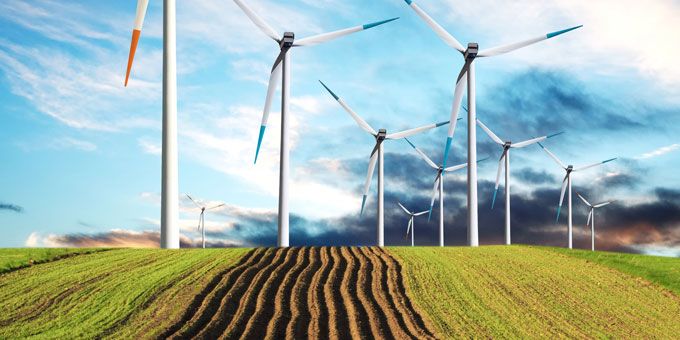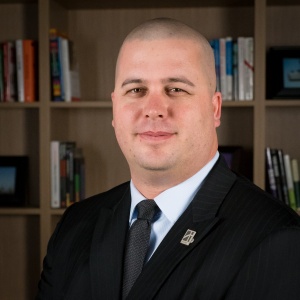For a Wind for Industry® project to be viable, the wind resource must be attractive, the factory must use enough energy, and the area grid pricing must exceed our projected rates.
 30% of U.S. Counties are Suitable for On-Site Wind Energy Projects
30% of U.S. Counties are Suitable for On-Site Wind Energy Projects

Jereme Kent | One Energy
Tell us a bit about One Energy and your role in the alternative energy industry?
One Energy is an industrial power company and the largest installer of on-site wind energy in North America. In 2009 we recognized that energy consumers are fed up with the failings of legacy utilities, so we spent the last 10 years developing modern energy services to control cost and risk. Our turnkey solutions for commercial and industrial (C&I) energy users are our Wind for Industry® and Managed High Voltage programs. By putting the end-user in control, One Energy believes we are building the customer-centric grid of the future.
We’re a unique option in the alternative energy industry because we offer projects on a scale between residential turbines and Big Wind projects. We’re an on-site option for large energy consumers, using utility-scale projects. Our projects feed directly to the end-user’s facility, so they receive the energy directly from their turbines instead of just paying for Renewable Energy Credits (RECs) or signing a virtual Power Purchase Agreement (PPA).
What is the TAM report and what does it mean for potential investment in wind energy?
The TAM report is a study conducted by One Energy to assess the Total Addressable Market (TAM) of Wind for Industry®. It ultimately concludes that the near-term Wind for Industry® market is effectively infinite. Investing in it means investing in growth.
Our study looked at three main elements: wind, manufacturing, and economics. For a Wind for Industry® project to be viable, the wind resource must be attractive, the factory must use enough energy, and the area grid pricing must exceed our projected rates. Our findings show those three factors align in much of the U.S., confirming One Energy can easily serve a several-gigawatt market.
The global C&I electricity market is a $1.6 trillion industry. The U.S. C&I market is worth more than $200 billion annually. And the U.S. TAM for Wind for Industry® alone is worth several billion dollars per year.
As a company largely based Ohio, is One Energy prepared to expand nationwide to meet the market potential outlined in this report?
Yes. One Energy is vertically integrated, we do everything from planning and developing the projects, to constructing the turbines, to operations and maintenance. This provides us with the resources and the capability to scale as our market grows. One Energy has already taken several steps towards staying ahead of this growth. We’ve created regulatory plans of action to enter other states, we’re planning for the use of larger rotors for a 10% energy output increase and thus a 10% cost improvement, our construction team is becoming increasingly efficient to meet our 90-day installation goal, and we’re consistently hiring to ensure we have the people we need to develop and maintain projects as the on-site wind market expands.
How does the Wind for Industry® program work?
One Energy has designed Wind for Industry® to make wind energy simple. If a customer is interested in a project, One Energy recommends a site tour of an operating project. This helps the customer see firsthand how our projects work. One Energy will do a feasibility study of their site to know if wind is right for their company. If it works for their site, One Energy will conduct the full due diligence, engineering, and permitting for the project at no cost to the customer before a power purchase agreement (PPA) is signed. The project is expected to be operational within 6 months and One Energy will operate and maintain the project in conjunction with the turbine supplier for the lifetime of the project.
How is on-site wind energy cheaper and more efficient than traditional plugging into the grid?
With on-site generation your power is coming straight from your backyard. When receiving power from the grid, it’s coming from miles away and its subject to the costs associated with getting it there. Many costs associated with the grid aren’t required with on-site generation, like transmission and distribution of power and infrastructure upkeep. Our PPA contract locks in a 20-year fixed-rate for power that includes all costs associated with the project: one rate for everything from project development to operations and maintenance. This rate is fixed for the lifetime of the project and is not subject to the volatility of the electricity market. If the grid rates go up, then so do your savings.
What have been some of the biggest challenges in developing on-site wind projects?
One Energy has developed a process for on-site wind projects that is vertically integrated and efficient. We are experienced with everything from development, engineering, construction, and financing. Due to this experience we are able to make the project hands-off for our customers. The biggest challenge is convincing the customer that the process really is that simple and ready for their signature.
Are some parts of the country better than others in terms of regulations for on-site wind projects?
Yes and no. Each state has its own guidelines that apply to distributed generation. We have researched and vetted the process for national expansion and what it will mean for our regulatory team, and we’ve found that states propose a unique set of opportunities and obstacles. What One Energy is doing is in uncharted territory - and we are working hard to pave a way for our projects and for other projects like them.
How would a manufacturing facility best get started on the road to installing a wind energy system?
A manufacturing facility considering installing a wind energy system should look into a couple of factors: land availability near the facility and the amount of electricity consumption at the facility. If these factors line up, One Energy has created a page to help answer more detailed questions about what a project would mean at your site. www.considerwind.com can answer any question that a company might have and allows anyone interested to contact us to set up a site screening and visit.
About Jereme Kent
 Jereme has the complete set of skills necessary to develop, design, and build a wind project from a blank piece of paper. Prior to founding One Energy, Jereme ran construction of several of the world’s largest wind projects for utility-scale construction firms including RMT, M.A. Mortensen, and D.H. Blattner, and has overseen more than half a billion dollars in wind turbine construction projects. Jereme developed several safety, quality, and production methods that are considered standard within the utility-scale wind industry. He also pioneered the concept of just-in-time construction for utility-scale wind turbine projects.
Jereme has the complete set of skills necessary to develop, design, and build a wind project from a blank piece of paper. Prior to founding One Energy, Jereme ran construction of several of the world’s largest wind projects for utility-scale construction firms including RMT, M.A. Mortensen, and D.H. Blattner, and has overseen more than half a billion dollars in wind turbine construction projects. Jereme developed several safety, quality, and production methods that are considered standard within the utility-scale wind industry. He also pioneered the concept of just-in-time construction for utility-scale wind turbine projects.
The content & opinions in this article are the author’s and do not necessarily represent the views of AltEnergyMag
Comments (0)
This post does not have any comments. Be the first to leave a comment below.
Featured Product

